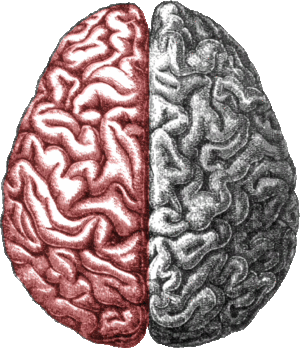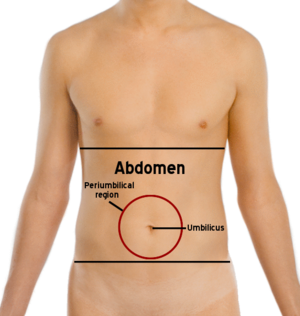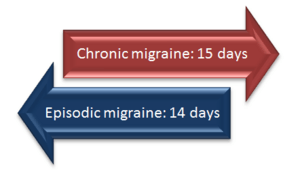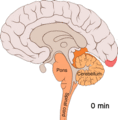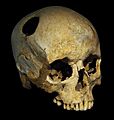Migraine facts for kids
A migraine is a special kind of headache that can be very strong. It often causes a throbbing pain, usually on one side of your head. This pain can be so bad that it makes it hard to do anything. While most people with migraines get a headache, some types of migraines don't cause head pain but have other symptoms.
Most migraines come with a headache, feeling sick to your stomach (nausea), and sometimes dizziness. You might also become very sensitive to bright lights or loud noises. Some people experience "auras" before a migraine starts. An aura means your vision or other senses change. You might see funny patterns, have blurry vision, or even lose some sight for a short time. Other senses can also change, like smelling or tasting strange things. Migraines can last a while, usually about 4 hours, but some can go on for up to 72 hours (3 days!).
Doctors classify migraines by how often they happen. If you have headaches for less than 15 days a month, it's called an episodic migraine (EM). If it happens for 15 or more days a month, it's called a chronic migraine (CM). "Chronic" means it happens over a long time. Sometimes, people who start with episodic migraines might later get chronic migraines. It's also possible for chronic migraines to go back to being episodic.
We don't know the exact causes of migraines for sure. People used to think they were mainly caused by problems with blood vessels in the brain. However, now experts believe migraines start with a problem in the central nervous system (your brain and spinal cord). When certain things trigger this problem, it sets off a chain reaction in your body. This reaction can affect the trigeminal nerve, which is a large nerve in your head, and the blood vessels that supply blood to your brain.
There are different things that make a person more likely to have migraines. Being female is one risk factor, and so is having family members who get migraines. For people who already have migraines, certain "trigger factors" can set off an attack. For many females, a main trigger is when the amount of the hormone estrogen in their body drops too low or fluctuates (goes up and down).
The World Health Organization says that migraine headaches are a very costly brain problem. This is true for both treatment and how much they affect people's ability to work or do daily activities in places like the European Union and the United States.
Contents
Types of Migraines
Migraine with Aura
Some migraines come with an "aura" before the headache starts.
- Acephalgic migraine: This is also called a silent migraine. It's a type of migraine with aura but without the head pain. This kind usually starts when a person is over 40 years old and becomes more common as people get older. Unlike other migraines, males get acephalgic migraines more often than females.
- Basilar-type migraine: This migraine with aura usually causes a headache at the back of the head. It also comes with nerve-related symptoms that seem to come from the brainstem, which is a part of the brain. This type is more common in people under 20 and young females.
- Familial hemiplegic migraine (FHM): This type of migraine with aura can also cause temporary weakness or paralysis on one side of the body. When the migraine stops, the person can move normally again.
- Retinal migraine: This migraine causes repeated times of vision loss in one eye. This loss of vision might happen before or during a headache. People who have retinal migraines usually have had other common types of migraines before.
Migraine without Aura
These migraines do not have an aura before the headache.
- Menstrual migraine: This type of migraine happens perimenstrually, which means around the time of a woman's monthly period. Menstrual migraines are usually without aura, but sometimes they can have an aura. About 7% to 14% of women only get migraines during their period. These are called true menstrual migraines. Most women who get migraines experience them at all times during their cycle, but they have more attacks around their period. These are called menstrually related or menstrually triggered migraines. Both types are grouped under menstrual migraine.
- The role of estrogen:
-
-
- Estrogen is a hormone mostly made in a woman's ovaries. For women who have migraines, it's often linked to their period. About 60% of women have these menstrual or menstrually-related migraines. The main trigger is thought to be lower levels of estrogen in the body, especially a type called estradiol. Sometimes, it's not just too little estrogen, but the fluctuation (going up and down) in estrogen levels that can trigger a migraine.
-
Childhood Periodic Syndromes
Childhood periodic syndromes are a group of migraine-related conditions that children can have. If a child has one of these syndromes, they have a higher chance of getting one of the more common types of migraines when they become adults.
- Abdominal migraine: This is a kind of migraine that causes very bad pain in the belly area, usually around the belly-button (called the periumbilical area). Abdominal migraine usually affects children starting around age 7, but it can affect younger or older children, and sometimes even adults.
- Benign paroxysmal vertigo of childhood (BPVC): This means harmless dizziness that happens suddenly and repeatedly. It usually starts in children between two and five years old and often goes away by age eight. BPVC causes vertigo, which is a feeling that you or the world around you is spinning.
- Cyclic vomiting syndrome (CVS): This is a medical condition where the main symptoms are feeling sick (nausea) and repeated vomiting. CVS happens more often in children but can occur at any age.
Chronic vs. Episodic Migraine
Episodic migraine (EM) means a person has migraine symptoms for 14 days or less in one month. Chronic migraine (CM) means a person has migraine symptoms for 15 or more days in one month.
People with chronic migraine are less likely to have full-time jobs and have a higher risk of being unable to do things because of their headaches. They are also almost twice as likely to have anxiety, long-lasting pain, or depression. They have a 40% higher chance of having heart disease and a 70% higher chance of having had a stroke.
About 7.68% of all migraine cases are chronic migraines. In the United States, about 1% of people have CM. It's more common in females, middle-aged people, and those from households with lower incomes.
Understanding Aura
Aura comes from a Greek word meaning "breeze." It describes a set of neurological symptoms that can happen before a migraine headache. About 15% of people who get migraines will experience an aura. These symptoms can include vision problems like scotomas (losing vision for a short time, seeing zig-zag lines, or floating spots), vertigo (dizziness), a ringing noise in the ears (tinnitus), and trouble speaking.
A scotoma comes from the Greek word for "darkness." It's like a blind spot or an area where your vision is reduced, even though the rest of your vision is normal. For example, you can see normally, except for the spot where the scotoma is. Scotomas can affect one or both eyes. They can be absolute, meaning you can't see anything at all within the spot, or relative, meaning you can still see a little bit within the area.
Scotomas can also have different patterns and shapes. A fortification scotoma is called that because it looks like the outline of an old fort. Scotomas can start small and then get bigger, move around in your vision, and sometimes even look like flickering lights.
History of Migraines
Symptoms that seem like migraines have been written about in different cultures throughout history. The first known mention was found on ancient clay cuneiform tablets from Babylonia, dating back to 2000-1880 BCE.
A treatment for migraine can be found in the Ebers Papyrus, an ancient Egyptian medical text. This text, from 1552 BCE, refers to migraine as "suffering in half the head."
| Another remedy for suffering in half the head. The skull of a catfish fried in oil. Anoint the head herewith.-Ebers Papyrus,1552 B.C.E. |
The ancient Greek doctor Aretaeus of Cappadocia described a type of headache he called heterocrania, which is now thought to be a description of migraine.
Images for kids
-
A trepanated skull from the Neolithic period (Stone Age). The edges of the hole in the skull are smooth, which means the person survived this ancient operation.
See also
 In Spanish: Migraña para niños
In Spanish: Migraña para niños


